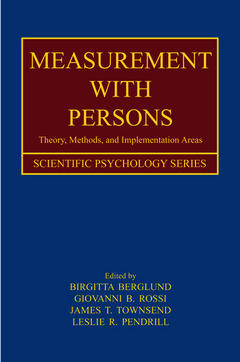Description
Measurement With Persons
Theory, Methods, and Implementation Areas
Scientific Psychology Series
Coordinators: Berglund Birgitta, Rossi Giovanni B., Townsend James T., Pendrill Leslie R.
Language: English
Subject for Measurement With Persons:
Keywords
uncertainty; magnitude; estimates; fusiform; face; area; admissible; transformations; functional; magnetic; ERP Component; Lateral Occipitotemporal Cortex; Luminous Intensity; Measurement Uncertainty; FBA; Conformity Assessment; MDS Technique; Membership Function; EEG Signal; Face Selective Areas; Pet Activation Study; Van De Riet; Tonic Stimulation; Van Heijnsbergen; OFA; Gaze Estimation; Affective Blindsight; ERP Waveform; Effective Connectivity; Dorsal Horn; FFA; Pain Perception; Short Term Sensitization; Repetitive Stimulation; Comparison Stimulus
422 p. · 15.2x22.9 cm · Paperback
Description
/li>Contents
/li>Biography
/li>
Measurements with persons are those in which human perception and interpretation are used for measuring complex, holistic quantities and qualities, which are perceived by the human brain and mind. Providing means for reproducible measurement of parameters such as pleasure and pain has important implications in evaluating all kind of products, services, and conditions.
This book inaugurates a new era for this subject: a multi- and inter-disciplinary volume in which world-renowned scientists from the psychological, physical, biological, and social sciences reach a common understanding of measurement theory and methods.
In the first section, generic theoretical and methodological issues are treated, including the conceptual basis of measurement in the various fields involved; the development of formal, representational, and probabilistic theories; the approach to experimentation; and the theories, models, and methods for multidimensional problems. In the second section, several implementation areas are presented, including sound, visual, skin, and odor perception, functional brain imagining, body language and emotions, and, finally, the use of measurements in decision making
Measurement with Persons will appeal to a wide audience across a range of sciences, including general psychology and psychophysics, measurement theory, metrology and instrumentation, neurophysiology, engineering, biology, and chemistry.
Part 1. Theory and Methods. B. Berglund, G.B. Rossi, A. Wallard, Measurement Across Physical and Behavioural Sciences. B. Berglund, Measurement in Psychology. T. Goodman, Measurement of Physical Parameters in Sensory Science. F.S. Roberts, Meaningful and Meaningless Statements in Epidemiology and Public Health. G.B. Rossi, Towards a Probabilistic Theory of Measurement. G.W.A.M. van der Heijden, R. Emardson, Multivariate Measurements. J.T. Townsend, D. Burns, L. Pei, The Prospects for Measurement in Infinite Dimensional Psychological Spaces. S. Link, Psychophysical Linguistics. E.N. Dzhafarov, Mathematical Foundations of Universal Fechnerian Scaling. C. Eitzinger, W. Heidl, Neural Networks and Fuzzy Systems. Part 2. Implementation Areas. P. Susini, G. Lemaitre, S. McAdams, Psychological Measurement for Sound Description and Evaluation. R. Hölzl, D. Kleinböhl, J. Trojan, Nociception and Pain in Thermal Skin Sensitivity. B.M. Velichkovsky et al., Measurement-related Issues in the Investigation of Active Vision. P.A. Della Rosa, D. Perani, Electrical and Functional Brain Imaging. C.B.A. Sinke, M.E. Kret, B. de Gelder, Body Language: Embodied Perception of Emotions. L. Pendrill, Risk Assessment and Decision-making.



